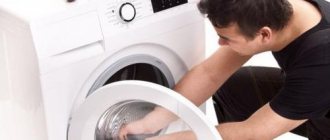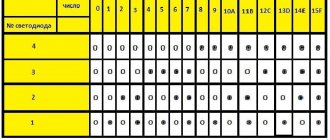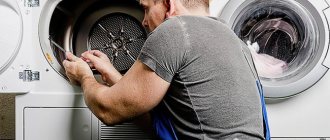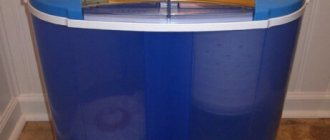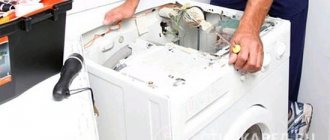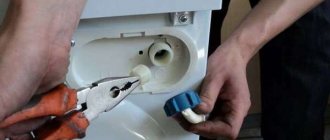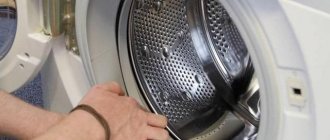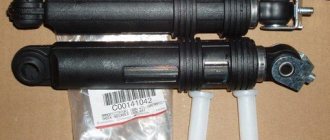Zanussi washing machines are widespread in apartments and houses. They are advertised and promoted as being from a trusted European brand. However, in practice, all products from this manufacturer, without exception, have weak points. Therefore, you need to know how to repair Zanussi washing machines when frequent breakdowns occur - this will help save time and money on calling a qualified specialist from the service center.
Features of the Zanussi washing machine
Without exception, all Zanussi machines, whether vertical or horizontal loading, are carefully designed engineering solutions. The manufacturer, on the way to conquering the market with reduced cost of products, got rid of most of the technological stocks. As a result of the machine:
- sensitive to the quality of tap water;
- have a drum block bearing that is quite sensitive to overloads and quickly fails when overloaded or unbalanced;
- require correct installation, including drain hose placement.
Also, due to power outages or voltage surges in the network, the electronic control board may fail. But in general, repairing a Zanussi machine when non-critical problems arise is not difficult. There are simple solutions for most problems. For example, the Zanussi machine circuit includes special means that allow you to manually unlock the door lock for storing laundry.
Typical breakdowns
Having studied statistical data from service centers that repair Zanussi washing machines, we can identify several typical problems for this brand:
- Related to water quality. Tap water in Russia is characterized by increased hardness. And there are problems with cleanliness - because of old pipes. As the water is heated to 90–95 degrees, a sediment forms—scale. Due to the sediment, the tubular electric heater (TEH) does not transfer heat well and overheats. Dirt and rust particles contained in the water clog the filters - the water intake and drainage system suffers.
- UBL (hatch blocking device). This unit breaks more often due to the fault of the manufacturer. There are obvious shortcomings here - the UBL and the sensor in the Zanussi SM fail more often than in devices of competing brands.
- heating element. Burns out due to scale buildup. In addition, it has a limited service life and may burn out after 3-5 years of intense use. But experts also assure that the heating elements of this brand have poorly selected components from which the tubular part is made.
- Drive belt. This element cannot boast of reliability. It is recommended to check the belt for integrity and tension once every three months. If there are stretch marks (damage), it will have to be tightened or replaced.
Common problems
One thing is certain: all problems in the operation of the machine are most often associated with the negligence of the owner. This may be an ignored instruction or incorrect installation. Housewives often overload or underload the drum, creating imbalances.
Even more cases of breakdowns are associated with improper operation and foreign objects entering the working paths of the device. There are also options when repairs are made due to wear and tear of system components.
Blockage
Clogging is a problem for all Zanussi cars without exception. This can be either a simple model or a fairly advanced device, for example, Aquacycle 800 or 900. All brand machines are very sensitive to the quality of tap water.
When installing the machine, it is recommended to install a separate fine filter at the inlet. It’s inexpensive and you won’t have to frequently remove the consequences of blockages.
If the machine is connected directly to the water supply, you need to clean the inlet filter mesh. Removing the blockage looks like this:
- the supply hose is unscrewed;
- unscrew the input filter from the machine body;
- the mesh is removed;
- cleaned and, if necessary, soaked in vinegar or a mild descaling agent;
- the filter is assembled, screwed into the housing, and a supply hose is connected to it.
You can often repair a machine with your own hands in this way. The filter device includes a procedure for removing and cleaning the mesh.
Extraneous noise during operation
Extraneous noise is the most common problem. This phenomenon may be caused by the following reasons:
- drum imbalance due to underloaded or overweight laundry;
- damage to the bearing block.
It is worth noting that malfunctions of a Zanussi horizontal-loading machine in the form of extraneous noise in any operating mode will most likely require the intervention of a qualified specialist. The cause is parts of mechanical components. This could also be a fairly harmless case when the shock absorber of the engine block is weakened or unbalanced. But the reason may lie in damaged bearings. In this case, the entire unit must be replaced.
Top-loading machines use a different type of drum mounting. In devices of this type, the unevenness of the load in the area of the bearing block is small, so extraneous noise, if it does not arise from loading laundry, but is present in all operating modes, necessarily indicates the complexity of the problem. Specialist intervention is required.
Bad spin
Poor spinning of laundry is always associated with the inability to achieve the required drum speed. The reasons for this phenomenon may be:
- insufficient supply voltage. Checked with a meter;
- poor belt tension causing slippage. The damage can be eliminated either by tightening or replacing.
But most often the machine begins to spin poorly when the laundry is loaded incorrectly. It may be overweight or underweight. In all cases, imbalance occurs and electronic control does not allow the engine to develop the required speed.
The problem can be solved either by dividing the laundry into two portions for separate washes, or by adding a clean towel and other things to the tank to gain sufficient weight.
Malfunctions related to water supply, heating, drainage
Partially the case when water is not supplied to the machine is described above. The problem can be resolved by cleaning the device's inlet filter. But the machine may not take in water due to a broken pressure switch. This happens rarely, but it does happen.
Zanussi devices have a rather complex unit of this class (in most models it is electronic), so you should contact a specialist to check and replace it. Water may not be drawn due to insufficient pressure. In this case, the pressure switch simply does not detect its presence at the input. Solving this problem also requires the intervention of a specialist.
Lack of heating may be due to a broken heating element. Most Zanussi car models have a display or display system. If the heating element breaks down, an error appears on the warning device.
This may be a character-numeric code or a combination of diodes. Based on the display readings, you should find the “faults and troubleshooting” section in the instructions for the Zanussi washing machine and determine the cause of the breakdown.
To repair the heating element, you will need skills in using measuring instruments and a soldering iron. An electrical tester will be required. By measuring the resistance of the heating element, its serviceability or winding breakage is determined. In the latter case, the wire leads to the heater contacts are unsoldered, the element is unscrewed from its socket and replaced with a new one.
The most unpleasant situation is when water is thrown out of the machine during washing. There are cases when water flows in and at the same time it is discharged into the sewer. Such problems are associated with incorrect installation of the device. The upper level of the drainage path must be raised no lower than the level specified in the instructions for the model.
Typically, Zanussi devices require the hose to be positioned at a height of at least 60-80 cm from the point of entry into the sewer. There is a special clip on the body of the machine for attaching it. Therefore, if the machine begins to drain water at the same time as filling or throws it away during washing, you should check the location of the outlet hose.
Hatch lock
Zanussi cars are equipped with a rather fragile blocker. Its locking system (locking teeth) is made of plastic. In addition, electrical control elements are located inside the unit. If the blocker refuses to lock the lock, you should:
- open the door;
- in the area of its handle, find on the body a block with two screws securing the safety plate with a square hole;
- carefully bend the rubber cuff in this area, after first removing the thin wire clamp that holds it in place;
- find the blocker with your hand and fix it;
- unscrew the screws;
- remove the cover and pull out the blocker;
- disconnect the terminal with wires.
The blocker needs to be changed in any case. The device may show obvious mechanical damage in the form of broken plastic teeth. The unit may not turn on due to a breakdown of internal electronic components, so the only solution is to purchase a new blocker model.
If the unit breaks down during washing and you cannot open the door, you should remove the lower decorative panel of the washing machine; a special cable is hidden behind it. To open the door, just pull it. Then you should follow the above scheme to remove the blocker. The new node is installed in the reverse order of steps.
Drum jammed
For users, the concept of “jammed” is quite broad. In the form of a list of options and methods for troubleshooting, it looks like this:
- entry of a foreign object. The drum refuses to spin or stops unexpectedly during the washing process. On top-loading machines, blocking may occur due to the loading doors not being closed. The problem is eliminated by removing the interference that has fallen between the parts of the structure;
- initial startup failure accompanied by a humming noise. This is a clear indication of problems with the bearing block. It is recommended to call a specialist;
- no rotation with the sound of the engine running. The problem may be either a break in the drive belt or it flying off the pulleys. If it is possible to disassemble the case and check the condition of the element and correct it, this must be done.
The most difficult locking problem is a broken bearing or drum spider. In these cases, expensive repairs will be required. It is also unpleasant for foreign objects to get into the machine. When the drum jams, the structure of the apparatus is inevitably damaged.
Heater circuit
The tubular electric heater is considered the most vulnerable part on a washing machine of all brands, and especially on Zanussi. Here, the coating used on heating elements is far from ideal, which often leads to rapid scale accumulation with subsequent problems. The washing machine, in this case, displays the fault code “E05” on the screen, indicating that it is impossible to heat the water.
To check and repair the heating element you must:
- turn the washer “backward” forward;
- remove the back panel by unscrewing the corresponding bolts;
- find the “trick” of the heating element - located under the tank with two contacts and wiring;
- touch the probes and measure the resistance.
A working heater should show 20-40 Ohms. Numbers closer to “0” will indicate that a breakdown has occurred. The heating element cannot be repaired; it must be replaced.
To remove the heating element, you need:
- unscrew the central nut;
- press the pin inward;
- release the connected wiring;
- remove the heating element.
It is recommended to use only branded spare parts for replacement. Third-party heating elements will not last long or will cause damage to the control board.
DIY machine repair tips
The rules for repairing Zanussi cars with your own hands are quite simple. It is necessary to correctly identify the problem. Error codes, frequently occurring malfunctions and methods for eliminating them are necessarily given in the instructions for a particular model.
The second correct tactic is to completely disconnect the device from all sources. This applies to both electricity and water. Only after this can you begin to check the cleanliness of the filters, the position of individual components and other work. In addition, you need to use working tools with insulated handles and carefully clean up water if it is spilled on the floor.
It is worth remembering: with proper installation, ensuring high-quality power supply and clean water, Zanussi washing machines operate without failures. In order not to struggle with problems, it is enough to properly operate your automated home assistant.
Error codes
The modern Zanussi automatic washing machine is equipped with a self-diagnosis function. Fault codes indicate a breakdown, but do not always allow you to understand its cause - you need to figure it out. The display shows error codes that you need to decipher and then decide what to do next. In difficult situations, contact the service. Below are some commonly encountered codes.
Table 1
| Code | The essence of the problem |
| E 11 | Water does not fill into the tank. The error is displayed for the following reasons:
|
| E 21 | The water does not drain. Clean the drain filter and check for blockages in the pipes |
| E 61 | The water did not heat up to the set temperature in the allotted time. The reason is the heating element is faulty. It is checked by a tester. If the heater is working properly, the resistance will be 30 ohms. |
| E 69 | Complete breakdown of the heating element |
In the instructions you can find a complete table of decoding codes - there are dozens of them, we have given only a few to clearly explain how the self-diagnosis system works.
Most common faults
If you follow all the points in the operating instructions, the washing machine will serve you for a long time. And if you carry out timely and high-quality service, then it will work uninterruptedly. Unfortunately, such an attitude towards technology is not always observed. Ruthless use without proper care leads to breakdowns. Sometimes quite serious. Only a service center technician can deal with them.
However, simpler breakdowns often occur that allow you to repair the machine yourself. The most common ones include:
- the drum does not spin;
- the hatch does not open after washing;
- water is drained simultaneously with its collection;
- water does not enter the machine;
- water heating does not work;
- leakage.
To eliminate such malfunctions with your own hands, you need tools and experience in performing plumbing and mechanical work.
Rumble during spin cycle
Loud noise when the drum rotates at high speeds may be due to the following reasons:
- The position of the machine is not strictly horizontal.
- The drum is underloaded, as a result of which the center of gravity of the laundry has deviated from the center of rotation (strong vibrations will occur at high speeds).
- One of the bearings is broken.
Bearings in Zanussi cars can be replaced independently. This is done like this:
- Having completely disassembled the machine, you need to remove the tank with the drum.
- After removing the drum pulley and unscrewing several bolts around the perimeter of the tank, the latter needs to be disassembled into two parts.
- Using careful blows of a hammer through a wooden lining, you need to knock out the drum axle shaft from the bearing assembly in the rear half of the tank.
- Next, using a puller, remove the bearing itself along with the seal.
- The drum axle shaft and bearing seat must be thoroughly cleaned.
- A new one is installed in place of the old bearing, and its seal is filled with special lubricant.
Having lubricated the axle shaft and the inner ring of the bearing, the drum and the rear part of the tank are again assembled into a single unit, after which both halves of the tank are fastened together, coating the joint with sealant.
Leakage
Malfunctions associated with water leakage cause great trouble, but are quite easy to fix. Usually this phenomenon provokes a weakening of the seals. A simple replacement of the gaskets at the hose connections will be enough to restore the machine’s functionality. It is somewhat more difficult to eliminate a hatch seal leak. You have to first remove the seal retaining clamp. This operation is easy if you carefully pry it off with a screwdriver. Replacing and installing a new seal usually does not cause any difficulties.
In order to repair a Zanussi washing machine at home, you need to understand electrical engineering and plumbing, have special tools and simple measuring instruments. In this case, success will be guaranteed.
In-line filter maintenance
Clogged filtration systems are one of the most common reasons why a Zanussi washing machine stops working. In such a situation, it becomes impossible to either drain or collect water. More often the filler filter “suffers”, becoming covered with limescale and dirt.
Fixing the breakdown is easy: just wash the filter built into the water pipe. If it is missing, the filter mesh installed at the junction of the inlet hose and the machine body is cleaned. We proceed like this:
- remove the top cover of the washing machine by loosening the corresponding bolts;
- look where the inlet hose connects to the body;
- find a mesh filter;
- Using pliers, remove the mesh from the seat;
- clean the filter (sometimes a toothbrush or toothpick is required);
- fix the mesh in the “nest”;
- We assemble the machine in reverse order.
Do-it-yourself cleaning of the intake filtration system on a Zanussi with vertical loading follows a similar pattern. It is worth understanding that the garbage filter located in the lower right corner of the machine often becomes clogged. Not only hard water is to blame here, but also too dirty clothes. Along with the fabric, hair, threads, sand, families, paper, coins and other debris get into the drum, which leads to problems with the pump. For prevention, it is recommended to clean the drainage every 3 months.
There is no electricity in the household electrical network
Let's simulate an unpleasant, but, unfortunately, typical situation. The drum is loaded, the powder is poured in, we insert the plug into the socket, but the automatic washing machine does not turn on, moreover, it does not react at all. First, it is necessary to exclude the influence of external factors, which are detected by the operation of a machine or RCD.
Electrolikbez!
For those who are not very versed in electromechanics, I will give a short explanation. A residual current device (RCD) is triggered if a leakage current occurs in the apartment's electrical network. That is, a terminal has become unscrewed in one of the electrical appliances, and the wiring supplies current to the housing. It is the RCD that protects the user from electric shock, and the wiring from overheating and fire. The machine (circuit breaker) disconnects the circuit in the event of a short circuit or overload. There is a third type - a differential switch that combines the functions of an RCD and an automatic circuit breaker.
Difavtomat
The first thing to do is unplug the washing machine from the socket. Then go to the apartment's electrical distribution panel and look at the position of the lever in the automatic machine. If necessary, move it from the “Off” position. (off) to “On” position (on). After turning on the difavtomat, we repeat the attempt to activate the socket, but using another device. For example, a table lamp. If the automatic circuit breaker works again, then the problem is in the socket. Its serviceability can be checked with an indicator screwdriver: the indicator should light only when in contact with one hole. When checking with a multimeter, the device is set to AC mode - ACV and the value is 220 V. The corresponding indicators should appear on the display. If the readings of the testing devices differ from the standard ones, then water has probably entered the outlet or the wires have burnt, and it needs to be replaced. If everything is fine with the socket, then the problem is in the washing machine.
IMPORTANT!
Do your own electrical wiring repairs only if you are 100% sure of the quality result. Otherwise, it is better to invite a specialist.
Control board
The user sets the desired washing parameters by pressing keys on the control panel. You can select the desired mode by rotating the selector knob, activate additional functions, adjust the temperature and the number of revolutions. The “tidy” is connected to the main electronic module.
Zanussi's main control board consists of semiconductor elements: microcontroller, triacs, capacitors, triggers, thyristors, resistors. Communication with the main parts and components of the machine is carried out via electrically conductive paths.
It is the control board that ensures the sequential execution of cleaning programs. All available washing algorithms and parameters are pre-recorded in the electronic module circuit. This gives the user the opportunity to launch the required mode without errors using the dashboard.
Some washing programs are carried out strictly according to the algorithm recorded in the “intelligence”. Individual modes can be adjusted - changing the water heating temperature and spin speed.
Hatch lock
Let's consider two situations:
The washing is completed, but the hatch still cannot be opened
If the lock is jammed, the hatch can be opened using the emergency cable by pulling it towards you. You can find it behind the bottom panel (you need to unscrew it), on the right, near the filter. The cause of the malfunction lies in the electronics, so you will have to contact a workshop.
The hatch won't close
The latches that hold the hatch in the closed position are made of fragile plastic, so they often break.
To make sure that this is the case, you need to disassemble the lock:
- Having opened the hatch, unscrew the two screws that secure the lock to the body;
- remove the hatch seal (cuff), having first removed the clamp holding it (you need to pry it off with a screwdriver);
- After removing the cuff, the lock can be pulled out.
If the plastic parts of the mechanism are really broken, you need to purchase a new lock and install it in place.
To make the lock last longer, close the hatch as gently as possible.
Call a specialist
We will call you back within 15 minutes to arrange a convenient time for your visit.
Districts
- Altufyevo
- Babushkinskaya
- Baumanskaya
- Bibirevo
- Biryulyovo East
- Brateevo
- Bratislavskaya
- Rokossovsky Boulevard
- Central Administrative District
- Chertanovo
- Golyanovo
- Gorbushka
- Kolomenskaya
- Kozhukhovo
- Krasnopresnenskaya
- Kuntsevo
- Kuzminki
- Lyublino
- Medvedkovo
- Mitino
- Novogireevo
- Novokosino
- Novo-Peredelkino
- Otradnoe
- Pavshinskaya floodplain
- Printers
- Perovo
- Polezhaevskaya
- Preobrazhenskaya Square
- Peace Avenue
- River Station
- Ryazan Avenue
- SAO
- Northern Butovo
- Lilac Boulevard
- Sokolniki
- NEAD
- SZAO
- Teply Stan
- Tushino
- Southern Administrative District
- st. Academician Yangel
- st. Seleznevskaya
- SEAD
- South-Western Administrative District
- Varshavka
- Veshnyaki
- Voikovskaya
- Vykhino
- Company
- Zhulebino
Self-draining device
The situation when, simultaneously with the collection of water, it is discharged through the drain hose (before the drum begins to rotate), may be due to the low location of this hose. Its free end should be raised by 50 - 70 cm.
Self-draining will also occur if the drain pipe is damaged, only in this case the water will not flow out of the hose, but from under the machine.
More serious causes are failures in the control module or level sensor, which mistakenly turn on the drain pump.
Drum doesn't move
If you can clearly hear that the engine is running, then the problem is most likely in the drive belt. To inspect it, you need to remove the back panel of the machine body by unscrewing the screws that secure it.
Next we act on the situation:
- If the belt has come off one of the pulleys, it needs to be put back in place.
- If the belt breaks, you need to purchase and install a new one.
- If the belt is intact and in its place, but does not transmit rotation due to slipping, it means that it has exhausted its service life and must also be replaced.
If, during inspection, you find that the electric motor pulley does not rotate, it means that there is a more serious breakdown and you need to contact a service center.
